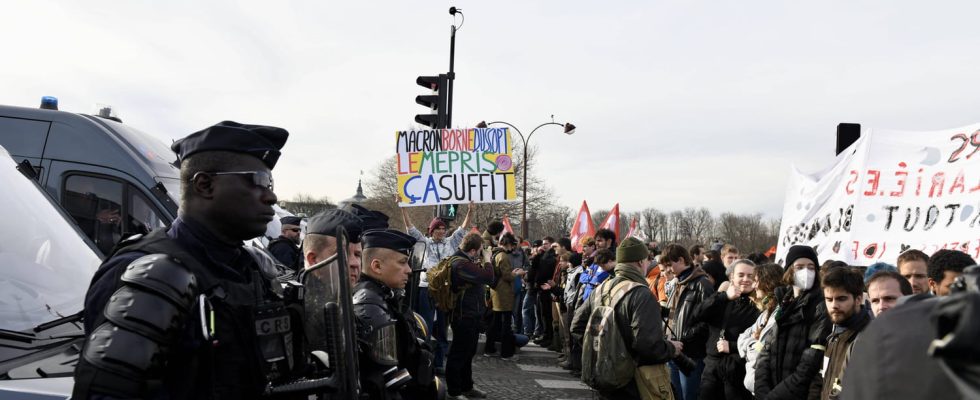DEMONSTRATION MARCH 23. The intersyndicale calls on the French to join the demonstrations of March 23 to fight against the pension reform, while spontaneous mobilizations, sometimes plagued by violence, are multiplying.
The anticipated and almost weekly demonstrations gave way to spontaneous and daily mobilizations. Since the government’s recourse to 49.3, the form of the mobilizations has changed but the objective has remained the same: to oppose the pension reform and obtain the withdrawal of the text. If the French take the lead, the unions have not given up their role and continue to organize the struggle and social mobilization, judging that spontaneous demonstrations and trade union movements can coexist. They have also set the date of Thursday, March 23 for the next day of demonstration and strike.
The extent of the mobilizations seen since last Thursday in Paris, Rennes, Bordeaux or Lyon – with thousands of people in the streets – gives hope to the unions to see the French come en masse to beat the pavement against the reform of the retreats this Thursday. A few minutes after the rejection of the motions of censure on March 20, the general secretary of the CFDT, Laurent Berger, notably called for “amplifying the mobilizations” and “massively participating in renewable strikes and demonstrations” on March 23.
Where will the March 23 protests take place? The map
The demonstrations of Thursday March 23 organized at the call of the inter-union are still being prepared but already nearly 200 rallies are planned by theUnsa. This figure is likely to climb in the coming hours. But more than the number of demonstrations, the unions especially hope to see that of the participants reach records.
What are the departures and routes of the demonstrations in Paris and France?
- Paris : at 2 p.m. from Bastille
- Lyons : at 11 a.m. from the Manufacture des Tabacs
- Toulouse: at 3 p.m. at the Saint-Cyprien metro station
- Nice: at 10 a.m. in front of the CADAM, at the Prefecture of the Alps-Maritimes
- Nantes: at 10:30 a.m. from the Water Mirror
- Montpellier: at 10:30 a.m. from Place Zeus
- Strasbourg: at 2 p.m. from Avenue de la Liberté
- Bordeaux: at 12 noon from Allées de Tourny
- Lille: at 2:30 p.m. from Porte de Paris
- Rennes: at 11 a.m. from Place de Bretagne
- Toulon: at 10 a.m. from Place de Liberté
- Le Havre: at 10 a.m. from Cercle Franklin
- Dijon: at 2 p.m. from Place de la Liberation
- Nîmes: at 2:30 p.m. from the Jardins de la Fontaine
- Clermont-Ferrand: at 10 a.m. from Place du 1er Mai
- Tours: at 2 p.m. from Place Anatole France
- Perpignan: at 10:30 a.m. from Place de Catalunya
- Rouen: at 10 a.m. from Cours Clémenceau
- Caen: at 2:30 p.m. from the Cargö
Dreaded violence at the demonstrations of March 23?
It is a fear that should not be minimized: that the demonstrations of March 23 will be parasitized by violence and degenerate. It is often in clashes between demonstrators and the police that the spontaneous mobilizations organized every day in several French cities end, while the previous mobilizations have all taken place in peace. The excesses and police violence observed on the evening of Monday March 20 after the rejection of the motions of censure are proof of this. 234 people were arrested in Paris, during the rallies near the National Assembly and then Place Vauban. Interpellations strongly criticized by rebellious elected officials as Mathilde Panotseveral of whom were present in the demonstrations, which denounce abusive arrests.
More than the arrests, it is also the police violence that is pointed out. Left-wing politicians and independent journalists have accused the security forces of inflicting disproportionate and violent blows. Of the pictures show many charges of CRS and members of the BRAV-M in Paris. More generally, it is the methods used by the police that provoke the anger of the demonstrators: beatings with truncheons, deployment of water cannons, use of tear gas or even trap operations. This last technique consists of surrounding a group of demonstrators “to prevent or put an end to serious and imminent violence against people and property”, but was deemed illegal by the Council of State in 2021.
These more virulent actions by the police are a response to unexpected and therefore unsupervised demonstrations according to the national delegate of the Alliance union, Johann Cavalero, guest on BFM TV : “The difference is that we have no interlocutors to prepare the course or to tell us what they want to do. We therefore adjust the system and we react to what is happening in face”. Since the demonstrations of March 23 were anticipated, such violence is not expected. But given the growing anger and possible resentment towards the police, the police could be more numerous to secure the processions.
